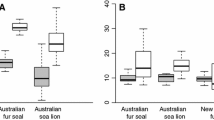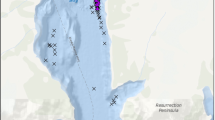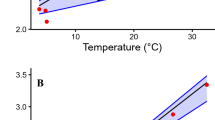Abstract.
Oxygen consumption of juvenile scalloped hammerhead sharks, Sphyrna lewini, was measured in a Brett-type flume (volume=635 l) to quantify metabolic rates over a range of aerobic swimming speeds and water temperatures. Oxygen consumption (log transformed) increased at a linear rate with increases in tailbeat frequency and swimming speed. Estimates of standard metabolic rate ranged between 161 mg O2 kg–1 h–1 at 21°C and 203 mg O2 kg–1 h–1 at 29°C (mean±SD: 189±15 mg O2 kg–1 h–1 at 26°C). Total metabolic rates ranged from 275 mg O2 kg–1 h–1 at swimming speeds of 0.5 body lengths per second (L s–1) to a maximum aerobic metabolic rate of 501 mg O2 kg–1 h–1 at 1.4 L s–1. Net cost of transport was highest at slower swimming speeds (0.5–0.6 L s–1) and was lowest between 0.75 and 0.9 L s–1. Therefore, these sharks are most energy efficient at swimming speeds between 0.75 and 0.9 L s–1. These data indicate that tailbeat frequency and swimming speed can be used as predictors of metabolic rate of free-swimming juvenile hammerhead sharks.
Similar content being viewed by others
Author information
Authors and Affiliations
Additional information
Electronic Publication
Rights and permissions
About this article
Cite this article
Lowe, .C. Metabolic rates of juvenile scalloped hammerhead sharks (Sphyrna lewini). Marine Biology 139, 447–453 (2001). https://doi.org/10.1007/s002270100585
Received:
Accepted:
Issue Date:
DOI: https://doi.org/10.1007/s002270100585




